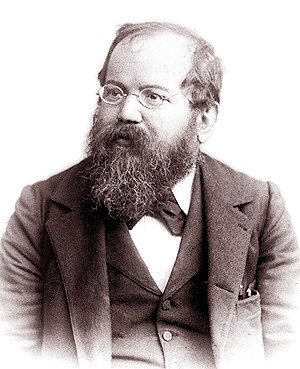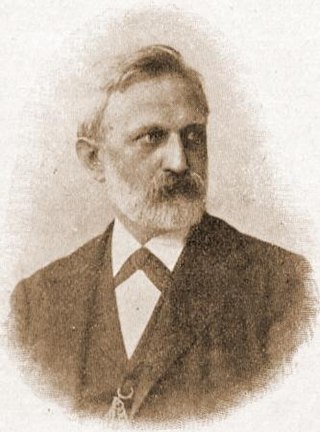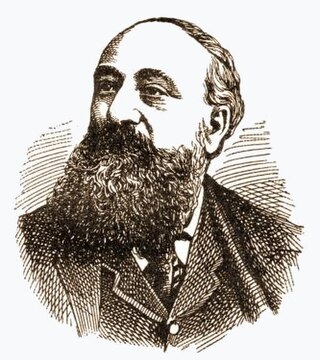
The World Chess Championship is played to determine the world champion in chess. The current world champion is Gukesh Dommaraju, who defeated the previous champion Ding Liren in the 2024 World Chess Championship.

William Steinitz was a Bohemian-Austrian, and later American, chess player. From 1886 to 1894, he was the first World Chess Champion. He was also a highly influential writer and chess theoretician.

Karl Ernst Adolf Anderssen was a German chess master. He won the great international tournaments of 1851 and 1862, but lost matches to Paul Morphy in 1858, and to Wilhelm Steinitz in 1866. Accordingly, he is generally regarded as having been the world's leading chess player from 1851 to 1858, and leading active player from 1862 to 1866, although the title of World Chess Champion did not yet exist.

Johannes Hermann Zukertort was a Polish-born British-German chess master. He was one of the leading world players for most of the 1870s and 1880s, but lost to Wilhelm Steinitz in the World Chess Championship 1886, which is generally regarded as the first World Chess Championship match. He was also defeated by Steinitz in 1872 in an unofficial championship.

Mikhail Ivanovich Chigorin was a Russian chess player. He played two World Championship matches against Wilhelm Steinitz, losing both times. The last great player of the Romantic chess style, he also served as a major source of inspiration for the "Soviet chess school", which dominated the chess world in the middle and latter parts of the 20th century.

Joseph Henry Blackburne was a British chess player. Nicknamed "The Black Death", he dominated the British scene during the latter part of the 19th century. Blackburne learned the game at the relatively late age of 17 or 18, but he quickly became a strong player and went on to develop a professional chess career that spanned over 50 years. At one point he was one of the world's leading players, with a string of tournament victories behind him, and popularised chess by giving simultaneous and blindfold displays around the country. Blackburne also published a collection of his own games.

Szymon Abramowicz Winawer was a Polish chess player who won the German Chess Championship in 1883.

Baron Ignatz von Kolisch, also Baron Ignaz von Kolisch (German) or báró Kolisch Ignác (Hungarian), was a merchant, journalist and chess master with Jewish roots.

Samuel Rosenthal was a Polish-born French chess player. Chess historian Edward Winter wrote, "He dedicated his life to chess-playing, touring, writing, teaching and analysing. Despite only occasional participation in first-class events, he scored victories over all the leading masters of the time. He also acquired world renown as an unassuming showman who gave large simultaneous displays and blindfold séances, invariably producing a cluster of glittering moves."

George Henry Mackenzie was a Scottish-born American chess master.

James Henry Gerard Mortimer was an American-born British chess player, journalist, and playwright.

Emil Schallopp was a German chess master and author. He became head of the shorthand department of the Reichstag. He wrote many books, including one on the Steinitz–Zukertort 1886 World Championship match. He is best known today as an author, particularly of the seventh edition (1891) of the Handbuch des Schachspiels.

London 1851 was the first international chess tournament. The tournament was conceived and organised by English player Howard Staunton, and marked the first time that the best chess players in Europe would meet in a single event. Adolf Anderssen of Germany won the sixteen-player tournament, earning him the status of the best player in the world.
The American Chess Congress was a series of chess tournaments held in the United States, a predecessor to the current U.S. Chess Championship. It had nine editions, the first played in October 1857 and the last in August 1923.

The second international Vienna 1882 chess tournament was one of the longest and strongest chess tournaments ever played. According to the unofficial Chessmetrics ratings, the tournament was the strongest tournament in history, on the basis that nine of the ten top players in the world participated, including all of the top eight.

George Hatfeild Dingley Gossip was an American-English chess master and writer. He competed in chess tournaments between 1870 and 1895, playing against most of the world's leading players, but with only modest success. The writer G. H. Diggle calls him "the King of Wooden Spoonists" because he usually finished last in strong tournaments.
World exhibitions became a new phenomenon in the West in the nineteenth century. Scientific and technical progress were shown. About a dozen World Fairs were organised during the second half of the nineteenth century. Seven times an international invitation chess tournament was part of the event. The third tournament took place in the Grand Cercle, 10 boulevard Montmartre, Paris, from 4 June to 11 July. Thirteen participants played in a double round-robin tournament. Draws counted as zero. The time control was ten moves an hour.

The London 1883 chess tournament was a strong chess tournament among most of the leading players of the day. It was won convincingly by Johannes Zukertort ahead of Wilhelm Steinitz. Remarkably, Zukertort was already assured of victory with three rounds to go, having scored an astonishing 22/23. He then lost his last three games against relatively weak players, probably due to exhaustion. The tournament established Zukertort as rivalling Steinitz to claim to be the best player in the world, and led to the World Chess Championship 1886 match between the two. The event was a double round-robin tournament. Marmaduke Wyvill contributed to organizing the tournament.
Henry William Birkmyre Gifford was an English chess master.
Karl (Carl) Pitschel was an Austrian chess master.
 Szymon Winawer (Poland)
Szymon Winawer (Poland) Johannes Zukertort (German Empire)
Johannes Zukertort (German Empire) Joseph Henry Blackburne (United Kingdom)
Joseph Henry Blackburne (United Kingdom) George Henry Mackenzie (United States)
George Henry Mackenzie (United States) Henry Edward Bird (United Kingdom)
Henry Edward Bird (United Kingdom) Adolf Anderssen (German Empire)
Adolf Anderssen (German Empire) Berthold Englisch (Austria-Hungary)
Berthold Englisch (Austria-Hungary) Samuel Rosenthal (France)
Samuel Rosenthal (France) Albert Clerc (France)
Albert Clerc (France) James Mason (United States)
James Mason (United States) H.W.B. Gifford (Netherlands)
H.W.B. Gifford (Netherlands) Karl Pitschel (Austria-Hungary)
Karl Pitschel (Austria-Hungary)











